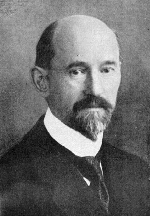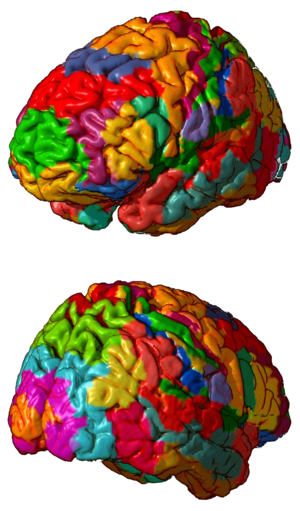Korbinian Brodmann facts for kids
Quick facts for kids
Korbinian Brodmann
|
|
|---|---|

Korbinian Brodmann
|
|
| Born | 17 November 1868 Liggersdorf, Province of Hohenzollern
|
| Died | 22 August 1918 (aged 49) |
| Nationality | German |
| Occupation | neurologist |
| Known for | defining Brodmann areas in the cerebral cortex |
Korbinian Brodmann (born November 17, 1868 – died August 22, 1918) was a German doctor who studied the brain. He is famous for creating a map of the cerebral cortex, which is the outer layer of the brain. He found 52 different areas, called Brodmann areas. He named these areas based on how their cells looked under a microscope.
Contents
Korbinian Brodmann's Early Life and Studies
Korbinian Brodmann was born in a place called Liggersdorf, which was in Germany at the time. He was born on November 17, 1868.
He wanted to become a doctor, so he studied medicine in several big German cities. These included Munich, Würzburg, Berlin, and Freiburg. In 1895, he earned his medical diploma.
After that, he continued his studies in Switzerland. He also worked at a university hospital in Munich. In 1898, he earned a special degree as a Doctor of Medicine from the University of Leipzig.
Brodmann's Work with Brain Doctors
From 1900 to 1901, Brodmann worked in a special clinic for mental health in Jena. He also worked at a mental hospital in Frankfurt.
While in Frankfurt, he met another important brain doctor named Alois Alzheimer. Dr. Alzheimer encouraged Brodmann to focus his research on the brain. This meeting helped Brodmann decide to spend his career studying how the brain works.
Brodmann's Important Brain Research
In 1901, Brodmann started working with two other famous scientists, Cécile and Oskar Vogt. They worked at a special institute in Berlin that studied the nervous system.
Later, in 1915, he joined the Max Planck Institute for Brain Research. This institute is still very important for brain studies today.
Mapping the Brain's Regions
In 1909, Brodmann published his most famous work. It was a book called Vergleichende Lokalisationslehre der Großhirnrinde. This long name means "Comparative Localisation Studies of the Cerebral Cortex."
This book showed the first map of the cerebral cortex based on its structure. He found that different parts of the brain's outer layer looked different under a microscope. These different parts later became known as Brodmann areas.
Later Career and Passing
After his work in Berlin, Brodmann moved to the University of Tübingen. He became a full professor there in 1913. For several years, he was also a doctor and led the anatomy lab at the university's mental health clinic.
He later moved to Halle and then to Munich. In Munich, he was invited to lead a group studying brain tissue at a research center.
Sadly, Korbinian Brodmann died suddenly in Munich on August 22, 1918. He was just under 50 years old. He passed away due to a serious infection that followed a lung illness.
What Are Brodmann Areas?
The brain areas that Korbinian Brodmann mapped are now called Brodmann areas. He found 52 different areas in total. He used many ways to map the human brain. He looked at the brain's overall shape and tiny structures inside it.
Brodmann believed that areas with different structures also had different jobs or functions. And he was right! Scientists later found that many of these areas are linked to specific brain functions, like:
- Brodmann area 41 and 42: These areas in the temporal lobe are important for hearing.
- Brodmann area 45 and 44: These areas are part of the Broca's area, which helps us with language and speaking.
- Brodmann area 1, 2, and 3: These are in the parietal lobe and help us feel touch, temperature, and pain.
- Brodmann area 4: This area in the frontal lobe is the main control center for our body's movements.
- Brodmann area 17 and 18: These areas in the occipital lobe are where our brain processes what we see.
Brodmann's work was influenced by Oskar Vogt, who also thought the brain had many distinct areas. Today, scientists often talk about these brain regions by what they do, rather than just their numbers. But Brodmann's numbers are still used in some cases.
See also
 In Spanish: Korbinian Brodmann para niños
In Spanish: Korbinian Brodmann para niños


